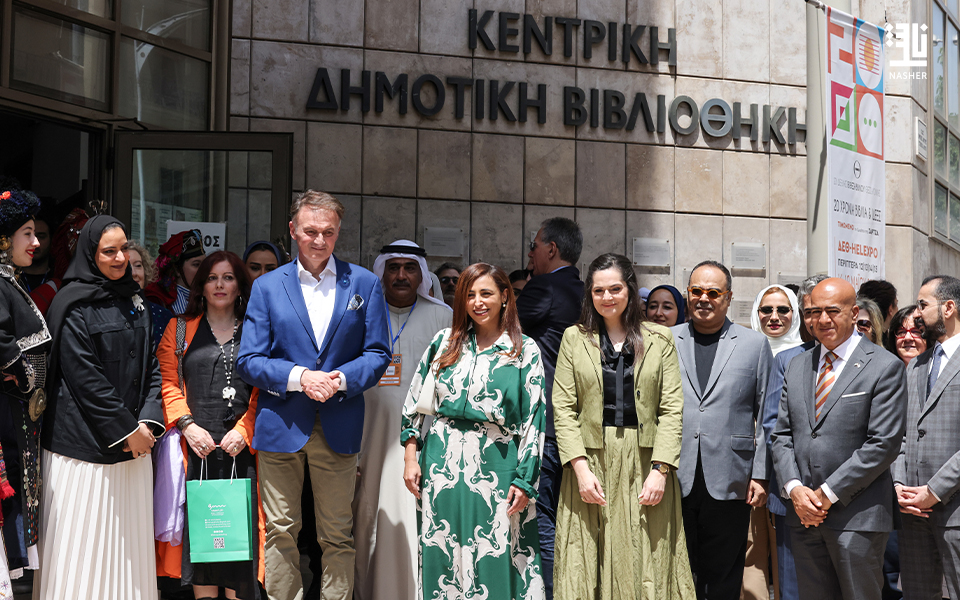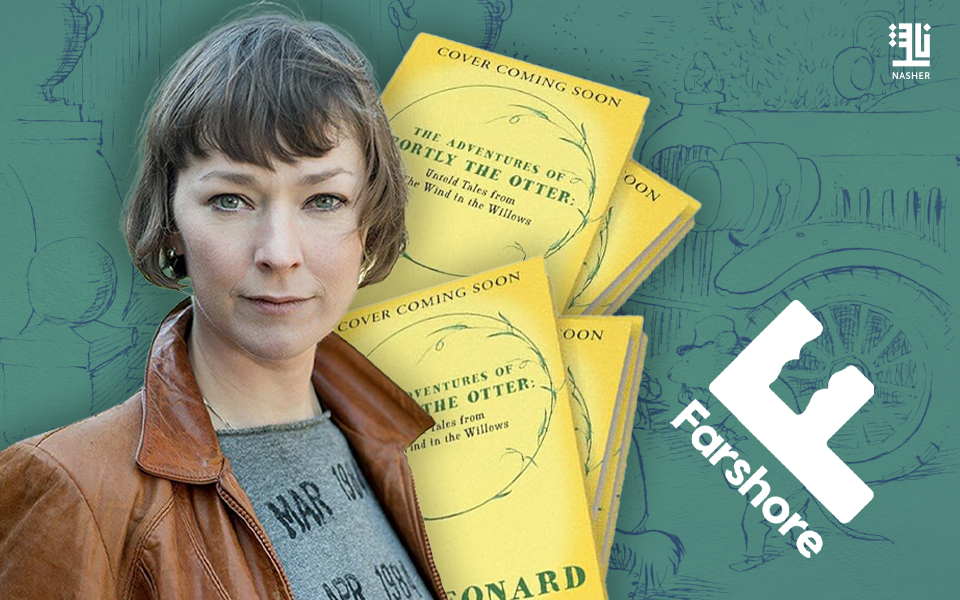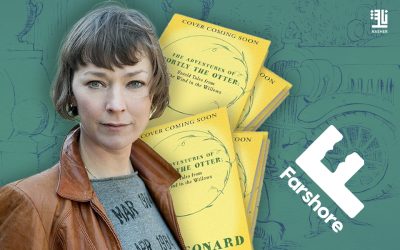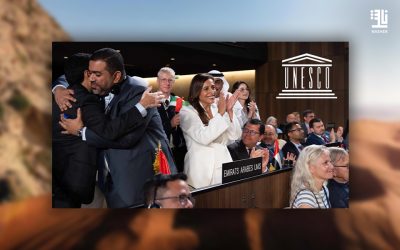As part of Sharjah’s participation as a Guest of Honor at the Thessaloniki International Book Fair 2024 (TIBF) in Greece, Sheikha Bodour bint Sultan Al Qasimi, Chairperson of Sharjah Book Authority (SBA) and Founder and Patron of the UAE Board on Books for Young People (UAEBBY), inaugurated the Greek edition of the ‘Folktales Reimagined’ exhibition, at Thessaloniki Central Library, organized by UAEBBY in collaboration with the Greek Board on Books for Young People (IBBY Greece).
During the exhibition, Sheikha Bodour bint Sultan Al Qasimi was briefed by Marwa Al Aqroubi, President of the UAEBBY, on the folk tales featured in the ‘Folktales Reimagined’ exhibition. Sheikha Bodour also met some of the Emirati and Greek artists who contributed to the production of this special edition of the exhibition, and applauded the outstanding talents involved and illustrators’ ability to reimagine the tales of other cultures in a way that preserves their spirit and original form as handed down from generation to generation.
With previous editions held in Italy, Mexico and South Korea, the Greek version of the exhibition features five Emirati artists and same number from Greece, who have introduced characters from the two countries’ most famous folktales and reimagined them with their own vision from the perspective of new generations and the reality of their experiences. In a dialog blending cultures and ideas, Emirati artists depicted the most popular Greek folktales, while their Greek counterparts reinterpreted the most famous Emirati tales.
The first edition of ‘Folktales Reimagined’ was held in Italy in March 2022 as part of the Bologna Children’s Book Fair, follow by the Mexican edition in December 2022 in the city of Guadalajara as part of the Sharjah Guest of Honor program at the 36th edition of the Mexico Book Fair. The 3rd edition was held last June in conjunction with the Sharjah Guest of Honor Program for the Seoul International Book Fair2023, with the participation of artists from the three host countries along with Emirati artists.
A confluence of thought and art to inspire generations
Marwa Al Aqroubi stressed that the Greek edition of ‘Folktales Reimagined’ is a continuation of the success of the Italian, Mexican and Korean editions of the exhibition, which contributed to promoting Emirati folklore and traditional tales among different cultures. “The various editions of ‘Folktales Reimagined’ exhibition have contributed to strengthening communication between peoples and cultures through literature and art, and allowed Emirati artists and illustrators to explore the heritage of other peoples and reimagine their folktales.”
Al Aqroubi pointed out that folktales are tremendous source of knowledge and culture, as their events, details and characters have contributed to shaping successive generations, and have played a major role in instilling social values and customs, and proper upbringing. “Organizing such exhibitions in different countries around the world would foster a dialogue in which cultures blend and ideas and perceptions meet to discover these tales in a renewed way that inspires current and future generations.”
Two different cultures… a common human heritage
As part of Greek artists’ re-imagination of Emirati folktales, artist Filomila Vakali – Syrogiannopoulou inspired her work from the traditional tale ‘Bu Assalasel’, which deals with a legendary character dressed as a human but carrying chains that restrict her enormous strength, and represents a testament to the untold mysteries of the desert and the unseen forces that dwell within.
Fellow Greek artist Vasilis Grivas chose to recreate the story of ‘UM KARBAH WA LEEFAH’, a fairy who lives in the trunk of a palm tree, rejecting injustice and bullying the weak. The story was told in front of children to prevent them from going out at night, making mistakes or doing unacceptable things.
Artist Emmanuela Kakavia participated in the exhibition with a work that depicts the tale of ‘Bu Ras’, a monstrous amalgamation of man and beast that prowls under the moon’s eerie glow. The tale aims to teach children patience, endurance, and the ability to face the unknown. In her artwork, artist Lela Stroutsi tackled the Emirati folk tale ‘ANNAGGAGAH’, a woman who is transformed into an owl by the jinn after losing her son and wanders around at night, screaming her sad cries in the hope of finding her lost son.
Finally, multi-talented Greek artist Gerasimos Galiatsatos found his passion in the Emirati folktale ‘FATTOUH’, a story of a glowing-eyed hero who is described by grandmothers to grandchildren as the only one who protects mangroves in the eastern region of Sharjah, specifically in the old city of Kalba, giving a warning message to anyone who tries to tamper with nature and destroy these beautiful trees.
As part of the Emirati artists’ contribution to retelling the Greek folktales that is still passed down from generation to generation, artist Moza Al Hamrani reimagined the story of “The Fox Who Had Lost His Tail.” It tells of a fox that fell into a hunter’s trap and lost his tail. To avoid being shamed alone, he gathers other foxes and tries to convince them to cut off their tails. The story depicts those who give advice to others only for their own benefit.
In a work of art that highlights the abilities of Emirati talent to reimagine Greek heritage, artist Zakia Alamry recreated the Greek tale ‘The Farmer and His Sons’, a story of a farmer who gave his sons a large bundle of sticks and asked them to break them, but they couldn’t. When the father dismantled the bundle and distributed the sticks to them one by one, his sons were finally able to break them easily, emphasizing that unity always makes us strong.
Under the title ‘The Turtle and The Eagle’, illustrator Noor Al Khamiri creatively incarnated the wisdom of the Greeks through a painting depicting the turtle who asked the eagle to train her to fly, ignoring that it was not created to fly in the sky. The turtle fell and died because she tried to do something that did not suit her nature. Her colleague Fatima Alameri re-imagined the popular story “The Boy Who Cried Wolf,” a cautionary tale reminds us that the credibility of habitual liars is tarnished, even when they speak the truth.
The fifth and last Greek folktale was ‘The Tortoise and the Hare’, depicted by Emirati artist Alia Jalabi. The story tells the tale of a race between a lazy rabbit and a diligent tortoise, which ended with persistence and effort trumping speed.







